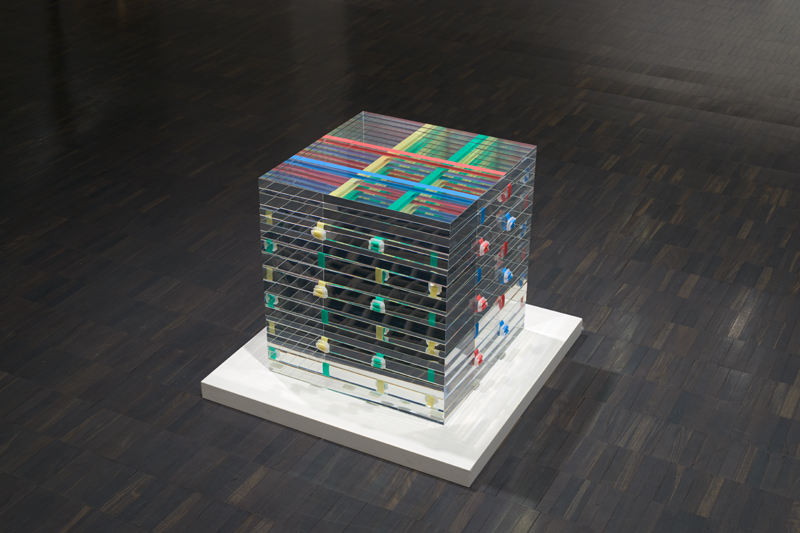Watch, Read, Listen
Recent Additions to the Collection MOMAT Collection Newsletter of the National Museum of Modern Art, Tokyo Tomii Motohiro, board band board #2, 2014
Back
board band board #2
2014
Acrylic boards and polypropylene bands
40.0 × 40.0 × 42.0cm
Purchased FY2020
Photo by Otani Ichiro
Fourteen acrylic plates, each with a thickness of 3cm, are stacked into a cuboid, with bands forming two color combinations, red / blue and yellow / green, alternately wrapping around 12 of the boards excluding the top and bottom ones. The bands are polypropylene, of the type used for packing corrugated cardboard.
To those somewhat familiar with postwar art, the approach and format of stacking identical rectangles will be reminiscent of the Minimalist art that emerged in the 1960s. However, the thin and insubstantial transparent material, the cheap appearance of the vibrantly colored bands, and the intricate and illusionistic device in which parts of bands sandwiched between plates disappear depending on the viewing angle give the work a light, airy feel that seems thoroughly unfettered by the complexities of art history.
Tomii Motohiro is an artist well known for three-dimensional works incorporating ready-made products. He has used a wide variety of mass-produced items including pushpins, bouncy balls, clips, pencils, and hammers. Tomii has described his practice as follows:
ー“What kind of structure should I select in order to let things exist both as they are and also as a unique object? The inherent conditions of each thing, e.g. size, material, weight, shape, and fixed images, determine the shape of a thing. The determined shape finds a new use for the thing, which is the most appropriate for itself. The newly adopted use is unique to the thing with this particular structure. From the moment of adoption, it is not a use anymore; it becomes a new condition of the thing. This quality is simultaneously restraint and potential. Autonomy can be achieved only from restraint.”
(“The Reason to Make,” statement on Tomii Motohiro’s website.)1
As this statement shows, Tomii’s attention is focused on two types of conditions, the inherent conditions of “things” (objects) and newly introduced conditions. The bands tightly and evenly wrapped around the acrylic plates create a “new condition” that gives color and structure to this work, but by not deviating from the bands’ “inherent condition” of practical use for wrapping, the work ensures that viewers remain aware of their status as packaging materials. Similarities and differences between the two conditions that arise from Tomii’s intervention contribute to the work’s charm and visual interest.
situations and so forth encountered in daily life on social media, in a series called “Today’s Sculpture.”2 With their odd combinations of objects, chance compositions, anonymous actions taken toward objects, and unintentional humor, all of these photographs clearly convey Tomii’s interests. The series should not be underestimated due to its casual presentation: these photographs are not only entertaining, but also offer fascinating hints as to how Tomii’s work guides objects from “inherent conditions” to “new conditions.” Please have a look for yourself.
[Notes]
(Gendai no me, Newsletter of The National Museum of Modern Art, Tokyo No.636)
Release date :


